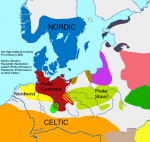Aldarc
Legend
Basically all just fancy talk for Norse Exceptionalism and Germanic Norse (obviously excluding the Finn/Sami) not being Germanic despite linguistic, historic, and genetic evidence. As CosmicKid says, you're wading into fringe theories.The word ‘Germanic’ is Non-Norse. It feels alien to Scandinavians.
Indeed, the concept of a ‘Germanic people’ is a fiction invented by Romantic Era German scholars. Humorously, the tribe that the Romans referred to as the Germanii is probably an unrelated Celtic tribe.
The Norse share linguistic influences with other ethnic groups, but these influences occurred during prehistoric periods. The transmission of these languages across genetically diverse ethnic groups still requires scientific explanations. To some degree, the influences are Scandinavian radiating outward. In any case, the respective ethnic groups continue to evolve differently. Various cognate terms mean different things in different languages. These are diverse ethnicities, with different genetic modalities, different cultures, different spiritualities, different experiences, and different influential neighbors.
Across the traderoutes of the Viking Period, Danmǫrk shares mutual influences with Saxland (today Germany) and even farther south to Roma. However Noregr and Svíþjóð share mutual influences with the Finnar (today Sámi and Suoma). Additionally, Noregr shares mutual influences with Írland and Skotland, and Svíþjóð shares mutual influences with Garðariki (today Russia and Ukraine).
The Norse themselves largely constitute the aborigines of Europe relating to Cro-Magnon. (Note the yDNA I1.) These prehistoric aborigines appear to be the origin of the unusually light complexion. Via the sustenance of hunting and fishing, the Norse preserved their aboriginal hunter-gatherer ways of life, including their animistic worldview. In the Viking Period, the Norse and the Finnar share similar non-urban worldviews. Both revere shamans as their only spiritual leaders (vǫlva and noaidi, respectively). Even today, there are Scandinavians who have experienced encounters with nature spirits, such as hulder and tusse. Icelanders similarly. In the psyche of the Norse, natural phenomena are mindful presences.
At worst, the use of the term ‘Germanic’ recalls the horror of N*zi German imperialism trying to appropriate Norse cultural symbols. At best, the term is scientifically inaccurate and a misnomer that misrepresents Norse identity.
More usefully, the term Norse relates to the term Norsk, and derives ultimately from the Old Norse term, Norrœnn, and accurately represents the aboriginal ethnic identity.
Last edited:











